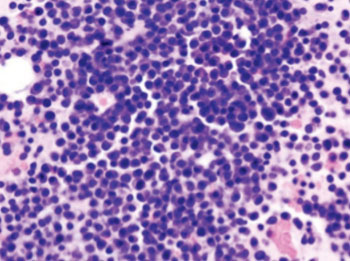MicroRNA Panel Appears Predictive for Progression to Multiple Myeloma
By LabMedica International staff writers
Posted on 13 Oct 2015
Eleven microRNAs (miRNAs) were found to be significantly decreased in both bone marrow (BM) and serum of multiple myeloma (MM) patients in comparison with controls and may form the basis for a blood test to diagnose the disease.Posted on 13 Oct 2015
miRNAs are fragments of RNA about 20 nucleotides long that block gene expression by attaching to molecules of messenger RNA (mRNA) in a fashion that prevents them from transmitting the protein synthesizing instructions they had received from the DNA.

Image: Micrograph of bone marrow aspirate showing the histological correlate of multiple myeloma (Photo courtesy of Wikimedia Commons).
According to the [US] National Cancer Institute, nearly 27,000 individuals will be diagnosed with myeloma in the US in 2015, resulting in about 11,240 deaths. Myeloma is the 14th most common cancer and the third most common blood cancer, after lymphoma and leukemia. Despite these statistics, a convenient screening test for MM has been lacking.
Investigators at the [US] National Institutes of Health (Bethesda, MD, USA) looked at miRNAs linked to MM as the basis for a possible diagnostic screening test. Towards this end, they analyzed fluid taken from the bone marrow of 20 patients with myeloma, which resulted in the identification of 111 miRNAs that showed a two-fold or greater difference from levels observed in eight control samples. Approximately 60% of the miRNAs were down-regulated and 38% were up-regulated.
Eleven miRNAs were significantly decreased in both BM and serum of MM patients in comparison with controls. Evaluation of these miRNAs in plasma of a separate cohort of MM patients and controls confirmed significantly abnormal levels of the miRNAs let-7a, let-7b, let-7i, miR-15b, miR-16, and miR-20a in both serum and plasma.
Investigators examined the pattern of myeloma miRNAs in precursor diseases to monitor changes as the disease progressed. They analyzed serum samples in 17 patients with MGUS (monoclonal gammopathy of undetermined significance), 17 with SMM (smoldering myeloma), 13 with myeloma, and 12 healthy controls. They found that only 4 of the 11 miRNAs (36%) that were reduced in the myeloma serum samples were lower in the MGUS samples. Eight of the 11 (73%) miRNAs were decreased in SMM plasma samples. However, three (27%) were significantly reduced only in the myeloma samples.
These findings suggested that these miRNAs were detectable in abnormal levels in the peripheral blood of patients with plasma cell proliferation and could play a role in aberrant plasma cell proliferation and disease progression.
"Our findings suggest that the antiproliferative and pro-apoptotic miRNAs, such as the let-7 family members, are down-regulated in multiple myeloma's microenvironment. These findings suggest that measuring expression of miRNAs associated with myeloma progression in the peripheral blood may hold promise for predicting disease progression in MGUS and SMM," said senior author Dr. Katherine R. Calvo, a researcher in the hematology section of the department of laboratory medicine of the [US] National Institutes of Health.
The study was published in the September 30, 2015, online edition of the Journal of Molecular Diagnostics.
Related Links:
[US] National Institutes of Health














